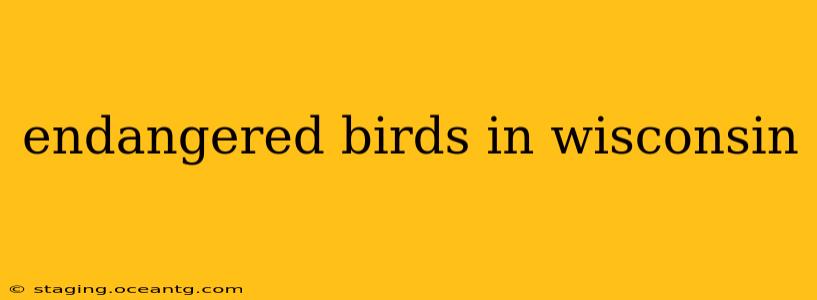Wisconsin, with its diverse ecosystems ranging from prairies to forests and wetlands, supports a rich avian population. However, several bird species face significant threats and are classified as endangered or threatened within the state. Understanding these threats and the conservation efforts underway is crucial for protecting these magnificent creatures. This guide delves into the endangered birds of Wisconsin, exploring the reasons behind their decline and the steps being taken to ensure their survival.
What Birds Are Endangered in Wisconsin?
Several bird species are currently listed as endangered or threatened in Wisconsin. The exact list can fluctuate based on ongoing assessments and research. However, some consistently vulnerable species include:
-
Kirtland's Warbler: This iconic bird is highly dependent on young jack pine forests for breeding, making habitat loss a primary threat. Successful conservation efforts, including controlled burns and jack pine planting, have seen some population recovery.
-
Piping Plover: This small shorebird nests on beaches and is vulnerable to habitat destruction from development, human disturbance, and predation. Protection of nesting sites and predator control are key conservation strategies.
-
Whooping Crane: Although a small, migratory population passes through Wisconsin, the whooping crane remains critically endangered globally. Habitat loss and collisions with power lines are significant threats.
-
Bald Eagle (Historically Endangered): While now removed from the endangered species list, the Bald Eagle's recovery serves as a powerful example of successful conservation. Continued monitoring is crucial to maintain their population stability. It's important to remember that while off the endangered list, they still require protection.
The Wisconsin Department of Natural Resources (DNR) maintains the most up-to-date list of endangered and threatened birds in the state. It's always best to consult their official website for the most current information.
What Are the Main Threats to Endangered Birds in Wisconsin?
Several factors contribute to the decline of endangered bird populations in Wisconsin:
-
Habitat Loss and Fragmentation: The conversion of natural habitats for agriculture, development, and other human activities is a leading cause of bird decline. Fragmentation, or the breaking up of large habitats into smaller, isolated patches, reduces breeding and foraging opportunities.
-
Climate Change: Shifting weather patterns, increased frequency of extreme weather events, and changes in precipitation can disrupt breeding cycles, migration patterns, and food availability.
-
Pollution: Pesticides, herbicides, and other pollutants can directly harm birds or contaminate their food sources. Light pollution can also disrupt bird navigation and behavior.
-
Invasive Species: Introduced species, like certain plants and predators, can compete with native birds for resources or prey on them directly.
-
Human Disturbance: Human activities, such as recreational use of nesting sites, can stress birds and reduce their reproductive success.
How Can We Help Endangered Birds in Wisconsin?
Protecting endangered birds requires a multifaceted approach:
-
Support Conservation Organizations: Many organizations are dedicated to bird conservation in Wisconsin. Donations and volunteer work can make a significant difference.
-
Protect and Restore Habitats: Supporting efforts to conserve and restore critical habitats is essential for bird survival. This can involve land acquisition, habitat restoration projects, and responsible land management practices.
-
Reduce Your Environmental Footprint: Making conscious choices to reduce your carbon footprint, minimize pesticide use, and support sustainable practices can all help mitigate the impact of climate change and pollution on bird populations.
-
Educate Yourself and Others: Learning about endangered birds and the threats they face is the first step towards taking action. Sharing this knowledge with others can raise awareness and inspire further conservation efforts.
-
Report Sightings: Reporting sightings of endangered birds to the Wisconsin DNR can help researchers monitor populations and track conservation progress.
What are the conservation efforts for endangered birds in Wisconsin?
Wisconsin's DNR works diligently with various partners on conservation efforts, including habitat restoration, species-specific management plans (like those for the Kirtland's Warbler), and public education campaigns. These initiatives aim to reverse population declines and protect critical nesting sites. These efforts are also closely intertwined with broader conservation initiatives focused on the Great Lakes region and beyond.
Are there any other birds of concern in Wisconsin?
While the birds mentioned above are formally classified as endangered or threatened, many other bird species face population declines and warrant ongoing monitoring. The Wisconsin DNR regularly assesses the status of bird populations and may update their lists of species of concern. It's wise to stay informed through their official resources.
By understanding the challenges faced by Wisconsin's endangered birds and supporting conservation efforts, we can play a vital role in securing their future and preserving the state's rich biodiversity.
